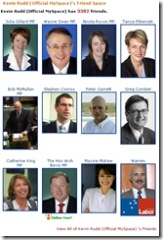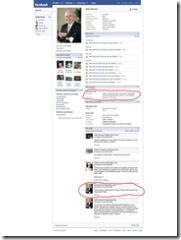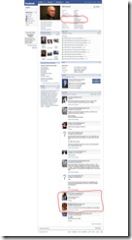Home » australia (Page 42)
Category Archives: australia
Happenings from and about Creative Commons in Australia
On the back of a lot of really interesting work and events last year, Creative Commons Australia have released their “Unlocking the Potential Through Creative Commons” report which examines the role (and potential roles) of Creative Commons licensing in Australia. It’s an easy read and has lots of examples, so very useful for artists, media producers, educators and many others who are thinking about the Creative Commons as the right copyright for their work!
Also in Australia, the CC Au blog looks at a recent controversy which has arisen due to Virgin Mobile in Australia using Flickr images licensed under Creative Commons terms. It appears Virgin may have ignored a CC ‘non-commercial’ clause in at least one case, but also on the table is the moral question of getting the permission of people who actually appear in the photos, especially since some of the advertisements put out by Virgin Mobile are clearly mocking in the people in the pictures. That said, clearly this is a very mainstream use of CC-licensed work and that’s definitely welcome. It’s also noteworthy that at least some of the photographers are delighted to see their work appearing as part of this campaign. For some of the more vitriolic comments which highlight the grey areas between intent and use, see the comments of these two Flickr images. It’s also worth checking out the online arm of Virgin’s campaign using these images (which, I have to say, is actually quite a clever use of some of these pictures!)
More broadly, last month Mary Taylor Huber from the US Carnegie Foundation for the Advancement of Teaching gave a series of guest talks here in Perth (you can hear Mary’s lecture here) and focused on what she calls building the ‘teaching commons’ which is, essentially, shared ideas and resources about teaching and learning across the globe. In our conversation after her public lecture, we were talking about the Creative Commons as the mechanism by which the actual resources of a teaching commons could be shared. Following that idea, I was absolutely delighted to see Creative Commons central announce that their CC Learn – “the education division of Creative Commons” – has gone live, with this fantastic mission statement:
* With legal barriers, we advocate for licensing of educational materials under interoperable terms, such as those provided by Creative Commons licenses, that allow unhampered modification, remixing, and redistribution. We also educate teachers, learners, and policy makers about copyright and fair-use issues pertaining to education.
* With technical barriers, we promote interoperability standards and tools to facilitate remixing and reuse.
* With social barriers, we encourage teachers and learners to re-use educational materials available on the Web, and to build on each other’s contributions.
Obviously CC Learn is in its early stages, but the mission is definitely a very important one and I can’t wait to see CC Learn grow!
Update (8.50am, 28 Jul 07): I’ve been reading more about the Virgin Mobile use of Flickr CC images and these posts are worth reading: “Uh, I thought YOU got the release . . .” by Carolyn E. Wright, looking at the need for model release forms for commercial use of people in photos; a post from Ian Wilson who was quite happy to see his image used by Virgin Mobile; Agency Spy’s “Flickr Is Going To Cost Virgin Mobile Millions Of Dollars“; and a longer conversation on Flickr “Virgin Mobile advertising campaign using Flickr photos“.
The US Presidential Race ’08 is now a pillow-fight between bikini-clad crush girls!
As Chuck and a quite a few others have pointed out, Barely Political have released another viral video, this time featuring an MTV style showdown between the singing, dancing political spokesmodel* Obama Girl and her political nemesis, Giuliani Girl:
I rather like Chuck’s description of this clip as a “a singing and dancing competition on the streets of Brooklyn that suggests a spiced up version of West Side Story, with a little politics thrown in.” As with the Obama Girl and Hott4Hill clips discussed earlier, the question as to whether these clips actually have any meaningful place in promoting political awareness is an important one. The lyrics certainly presume some knowledge of politics and of the candidates, but I suspect the demographic most likely to be watching the videos in YouTube are probably not of voting age.
As Craig Rubens from NewTeeVee asks:
Is this the “Happy Birthday Mr. President” of the YouTube era? The ladies of Barely Political owe quite a bit to the imitable Marilyn Monroe. Or is this more the Jib Jab of the 2008 election, whose This Land traveled in very much the same media circles back on ‘04?
I like the comparison with Jib Jab, as it certainly reminds us that US politics has already had its first election (’04) with viral video input, and the Crush Girl vids have some sort of history. That said, I also worry with Rubens that for all the cynicism about politics in the US, given such a narrow ranges of choices at the end of the day, these clips really could make a difference in an apathetic voter’s mind:
So, will Barely Political work its way up to political punditry levels of Stewart/Colbert? Likely not, but it’s broken new ground with the powers of viral videos, coming out with multiple iterations of a successful formula. I’d like to think that my vote won’t be influenced by Hooters girls chanting political candidates names, but like I said before, I am a member of an easily swayed demographic. So, while maybe not the most cerebral of political commentaries, Obama girl very well might be the most primal.
In a clearer light, it’s great to see Taryn Southern (who didn’t just perform, but also wrote the Hott4Hill clip) bemused by the fact that many commentators are missing the that fact that her clip, at least, is definitely satirical:
I’m still surprised at the number of people who don’t realize the video is a parody. Between Hillary’s face in Mt. Rushmore and my bikini body superimposed on George Washington crossing the Delaware, how could it get anymore silly?
Meanwhile, on the home front, the Oz in 30 Seconds citizen-produced political video campaign in Australia (run by GetUp) has entered the voting phase. Nothing as racy as the US clips, but some really impressive political commentary to be seen here!
* I’ve loved the term spokesmodel ever since hearing it for the first time in the wonderful film LA Story. I’m so pleased to finally have an appropriate context in which to use it!
Australian Politicians on MySpace this week…
The Australian ran a couple of stories today about Australian politics finding another outlet in MySpace’s ‘Impact’ website (the Australian version).
In Nicola Berkovic’s ‘Kevin has more ‘friends’ than John’, she points out that Labor is doing much better in MySpace than the Liberal Party. As Berkovic notes:
Yesterday afternoon, the Opposition Leader had more than 800 friends, while the Prime Minister had a measly seven. And most of them were fellow Liberal MPs. However, it is also a risky strategy for politicians, who are used to their minders having some degree of control over their image and political message. […]
Many of Mr Rudd’s MySpace friends are preoccupied with the issues that interest many young people: drinking, smoking and sex. […] However, Mr Rudd said, provided that people did not post defamatory or profane comments on his site, he was relaxed about losing control over his image on the internet. “It’s just life in the fast lane,” the Opposition Leader said.
I’d say Kevin Rudd’s attitude is probably a sensible one (and its not like any of the politician on MySpace are actually likely to see their own profiles). That said, in ‘MPs cast cyber net in hunt for votes’, Cath Hart points out that:
The emergence of e-campaigning in Australia is set to mirror the trend in the US, where presidential candidates have embraced the internet – for fundraising and profile building – as the 2008 race moves into full swing. Speaking at the launch of MySpace’s new political channel, Impact, yesterday, Mr Rudd described the site as the “public meeting place for the 21st century”, where his goal is “to get 50per cent … plus one more friend than Mr Howard”. “It’s a good shot in the arm for Australian democracy to keep it alive into the next century.” […]
But media and internet experts have warned Mr Rudd and the swag of other “e-MPs”, or online politicians, that social networking sites can be a double-edged sword. Internet networking expert Joanne Jacobs said the sites offered access to the “student market” of people under 24. “The trouble with these networking sites is that … they open the writer up to criticism. It also means you don’t have a moderating path to vet out unpopular comment,” she said.
Following Joanne Jacobs’ comments, I suspect the real test of Rudd’s take on social networking websites will come when he does something massively unpopular and has to deal with the backlash!
For today, thought, lets look at MySpace friends:
 Labor leader Kevin Rudd, has 3382 friends;
Labor leader Kevin Rudd, has 3382 friends;
 Julia Gillard (Deputy Leader for Labor) has 687 friends.
Julia Gillard (Deputy Leader for Labor) has 687 friends.
In the middle, Bob Brown (leader of the Greens) has 173 friends, while Democrat Senator Andrew Bartlett has 163 friends (although, already being Australia’s most web2.0-savvy politician, Bartlett already blogs extensively and has clearly stated that he only has time to treat MySpace as a re-posting space for his blog);
 Meanwhile, Australian Prime Minister John Howard only has 8 friends (and Peter Costello, oddly enough, isn’t one of them!). While the generation gap is clearly one factor, I strongly suspect that Howard’s camp simply aren’t checking friend requests (and thus Howard will probably never have more than 8 friends!). This is similar to what Jill mentions about politics in Norway, in that candidates are using online networks like MySpace or YouTube without having teams literate in how these websites actually work. (Another argument for the importance of digital literacies right there!)
Meanwhile, Australian Prime Minister John Howard only has 8 friends (and Peter Costello, oddly enough, isn’t one of them!). While the generation gap is clearly one factor, I strongly suspect that Howard’s camp simply aren’t checking friend requests (and thus Howard will probably never have more than 8 friends!). This is similar to what Jill mentions about politics in Norway, in that candidates are using online networks like MySpace or YouTube without having teams literate in how these websites actually work. (Another argument for the importance of digital literacies right there!)
Incidentally, the popularity of certain politicians doesn’t seem to be rubbing off on the youth arms of either major party: on MySpace the Young Liberals currently have 50 friends while Young Labor isn’t doing much better with 110 friends.
Returning to Australian Politics on Facebook discussed last week, Kevin Rudd is up to 1296 friends, while there still doesn’t appear to be a real John Howard. I’ll leave you to draw your on conclusions on that front!
(All friend counts and screenshots were taken between 3pm and 3.40pm Perth Time on 13 July 2007.)
Facebook and Australian Politics?
Over the past month I’ve suddenly seen Facebook grow from an oddity to something on which the majority of my university-based friends appear. Since I spent some of yesterday pondering the oddities of US politics and digital culture, I thought I’d spend a little of today looking at Australian politics. For those of you not in the know, Australia has what amounts to a two-party political system, divided between Liberal (close to Republican/Tory parties) and Labor (close to the Democrat/UK Labor parties); the Liberal party is led by John Howard, who is our current Prime Minister, while the Labor party, after many years of leadership ambiguity, is led by Kevin Rudd.
Unlike the US (and a lesser extent the UK), mainstream press and politics in Australia really hasn’t embraced either the blogosphere or social networking as a means of promotion or gaining support (and Australian politicians can’t and don’t fund-raise in the explicit way US politicians do). That said, younger voters are clearly looking for some sort of connection with the political sphere, even if its not done through the same rhetoric of civil participation that comes through the US education and advocacy systems. So, that said, is either Australia’s Prime Minster or his Labor rival on Facebook? The answer, initially, appears yes to both, although after some scrutiny, the answer changes to yes for Rudd and no for John Howard – there are, in fact, three Howards, but all are fake.
Of the three Howards, two are obvious fakes, while one is more subtle, but still not authentic. Since this is a fun moment to think about digital literacy, I’ve taken screenshots of the three Howard profiles and circled in red the most obvious indicators that these aren’t authentic pages.
and John Howard #3 …
In contrast, Kevin Rudd’s Facebook page is rather dull, but clearly authentic. (I’ve just made a friend request, so if there’s anything exciting in friends-only land, I’ll write a little more.) It is worth noting that comments which cast John Howard as a sexual or ‘hot’ figure are unambiguously meant to be satirical, in contrast to the clips from the US mentioned yesterday which, while playful, aren’t necessarily ironic (although they might be, especially Hott4Hill).
When Subiaco Oval Attacks!
The second half of 2007 hit with something of a bang today. The combination of extreme winds and the proximity of our place to Subiaco Oval suddenly led to the rather loud, dramatic and quite dangerous appearance of the massive advertising signs from Subi Oval hitting out (glass) back door and coming to rest in our back yard:
While fascinating on some level, these huge signs had to travel over the top of the oval (they’re supposedly fixed to the stands) and fly probably 50 metres in the air before spinning down into our place. It’s incredibly lucky that it was pouring with rain, too, because it anyone was outside, being hit by one of these could have caused some very serious injuries.
When the winds settled a little, Emily headed out the front door and discovered a whole lot more of these hoardings lying on our road and in the drive-way, so now we have four massive advertising banners on centimetre-think cardboard sitting soggily in our little backyard:
We now have part of an SGIO sign, a National Australian bank advertisement and something that has NTER in its lettering. I wonder when Subiaco Oval will be knocking on our door looking for them? Maybe they’ll offer to replant the bits of the garden that were sheered in half when the sign flew in from the sky?!
(Given that these signs cost advertisers anywhere from $5000 to $60,000 dollars each to display, I suspect someone might want them back!)
Indigenous Health is Australia’s Katrina?
While I was away, the health, welfare and abuse issues in some indigenous Australian communites has flared into the political spotlight. The issues aren’t new, but several new reports and issues have focused the debate markedly. That said, I was still quite suprised to hear Australia Prime Minister John Howard comparing these issues to the 2005 Katrina disaster in New Orleans:
“Many Australians, myself included, looked aghast at the failure of the American federal system of government to cope adequately with hurricane Katrina and the human misery and lawlessness that engulfed New Orleans in 2005,” he said in a speech to the Sydney Institute last night. We should have been more humble. We have our Katrina here and now. That it has unfolded more slowly and absent the hand of God should make us humbler still.”
The religious tones here seem particularly unhelpful, and casting this as Australia’s Katrina makes light of the fact that these issues are a systemtic issue which have been around for some time. Sending in the troops (literally) may not be the best approach for communities which still have very real memories of children being forcibly removed from families a generation earlier. That said, change has to happen, and I tend to agree here with Democrat Senator Andrew Bartlett:
There has been a fair degree of cynicism amongst many of the responses to the government’s plan, including from many Indigenous Australians. Given the past history of many grand government announcements which have not been followed up with adequate resourcing or implementation once the headlines have died down, there is every reason for people to be cynical. However, that should not be a reason to try to tear this plan down, it should be a reason to keep the focus on it, to do everything possible to translate all the current waves of rhetorical flourishes into real and lasting positive change.
For your own reading, please …
[X] Read The Northern Terrtitory Inquiry into the Protection of Aboriginal Children from Sexual Abuse and the many, many problems it describes (or, at least, look at the Foreward);
[X] See North Queensland Aboriginal leader Noel Pearson being interviewed last week on the 7.30 report about some of the strategies being implemented (which were recommended in a report he chaired);
[X] But also keep in mind that the timing of this is political since former WA premeir Geoff Gallup called this issue a “national disaster” in 2002 and called for broad-scale national and state-level action in that year (“There needs to be a national approach to this, it’s not just a Western Australian issue”). None happened until a closely run Federal election was looming. (That’s a reason to try and ensure that the energy galvanised here is directed in a sustained way, not a short-burst political way. And, to be honest, even gettings things right here doesn’t make up for all the years that the Howard goverment has done nothing, despite the issues being clear as day.)





